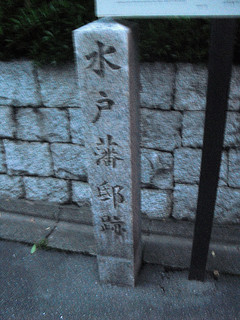Difference between revisions of "Mito han"
(Created page with "right|thumb|320px|Stone marker at the former site of the Mito domain's [[daimyo yashiki|mansion in Kyoto.]] *''Lords: Mito Tokugawa clan''...") |
(No difference)
|
Revision as of 14:05, 14 April 2013

- Lords: Mito Tokugawa clan
- Kokudaka: 330,000
- Japanese: 水戸藩 (Mito han)
Ruled by one of the Gosanke, or Three Tokugawa Branch Families, Mito Domain is one of the more prominent domains in Edo period Japan.
Mito was located a short distance north of the shogunal capital of Edo, in what is today Ibaraki prefecture. The domain is famous primarily for its development of a nativist and isolationist school of thought, known as Mitogaku, which would prove to align well with the sonnô jôi ("revere the emperor, expel the barbarians") philosophy which became popular in the Bakumatsu period.
In the Bakumatsu period, Lord of Mito Tokugawa Nariaki was influential and prominent in shogunal politics in Edo, and was a strong supporter of the maritime restrictions, and of not opening the country to the West. In the 1850s, after rôjû ("Elder"; lead shogunal advisor) Abe Masahiro gave in to the demands of Commodore Perry, and Abe's successor Hotta Masayoshi signed the Harris Treaty (and especially after Emperor Kômei refused to agree to the treaty, opening the ports to Westerners to trade, and granting them extraterritoriality), Nariaki and his supporters grew dissatisfied with the shogunate, and the sonnô jôi movement gained strength.
Following a shogunal succession dispute in which one of Nariaki's sons was among the claimants to the title, Ii Naosuke engineered a series of purges of Nariaki's supporters from the government. In return, Nariaki had Naosuke assassinated. In order to pacify the growing anti-shogunate sentiment of Nariaki's supporters, his son was named shogun. Hitotsubashi Keiki, also known as Tokugawa Yoshinobu, would turn out to be the last shogun.